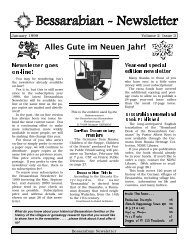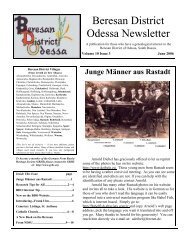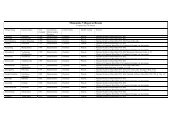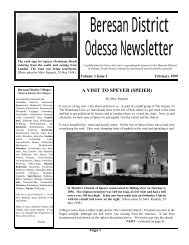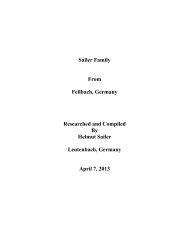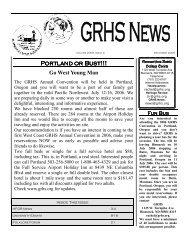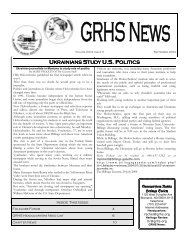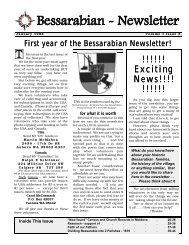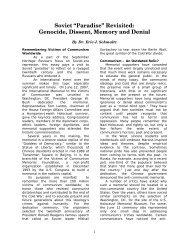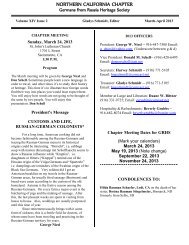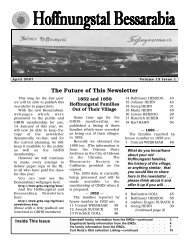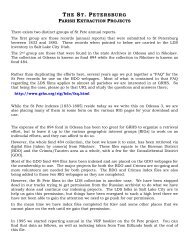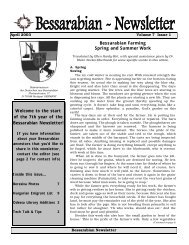Worms - 1848 Village History - GRHS Home Page
Worms - 1848 Village History - GRHS Home Page
Worms - 1848 Village History - GRHS Home Page
Create successful ePaper yourself
Turn your PDF publications into a flip-book with our unique Google optimized e-Paper software.
v v<br />
Volume 2 Issue 1 June 1997<br />
<strong>Worms</strong> - taken on June 28, 1996 by Gary Maier<br />
Beresan District<br />
INCLUDES:<br />
(Those in bold are first villages.)<br />
Alexanderfeld, Alexandrovka,<br />
Annenthal, Annovka,<br />
Antonowka, Bagdanovka,<br />
Benderhof, Biswanje, Christina,<br />
Christofovka, Domaneveka,<br />
Dvorjanka, Eigengut, Felsenburg,<br />
Friedensdorf, Friedrichstal,<br />
Gardegai, Gotta, Gradenfeld, Grise,<br />
Guldendorf, Halbstadt, Heck,<br />
Hoffmannstal, Hoffnung,<br />
Hoffnungsburg, Johannestal,<br />
Kantakusenka, Kapitanovka,<br />
Karlevka, Karlsruhe,<br />
Katharinental, Kavkas,<br />
Klein Karlsruhe, Klundovo,<br />
Kratovka, Landau, Lerisk,<br />
Lichtenfeld, Lubo-Alexandrovka,<br />
Manov, Marienfeld, Marlanavka,<br />
Michaelowka, Munchen,<br />
Navaselevka, Neu Karlsruhe,<br />
Neu Lustforf, Neu Munchen,<br />
Neu Rohrbach, Neu <strong>Worms</strong>,<br />
Neusatz, Novo-Amerika,<br />
Novonikolajevka, Olgino,<br />
Otschakov, Petrowka, Pokrovskaja,<br />
Rastadt, Rohrbach, Rosenthal,<br />
Savidovka, Schlosser, Schmatz,<br />
Schonfeld, Sebastiansfeld,<br />
Selingera, Skarupka, Sjepucha,<br />
Speir/Speyer, StadnaJa-Bulka,<br />
Steinberg, Steingut, Stuttgart,<br />
Sulz, Swenigorodka, Vossessensk,<br />
Waterloo, Weidenberg, Wilhelmathal,Wolksov,<br />
<strong>Worms</strong>, Wowtsche.<br />
(this list is not yet all inclusive -- if<br />
you have additions, please provide<br />
to the Lead Editor)<br />
Many of these identified chutors<br />
and villages need much research.<br />
If you have any background information<br />
on them, please share<br />
with us.<br />
<strong>Worms</strong> - <strong>1848</strong> <strong>Village</strong> <strong>History</strong><br />
Original Translation by Theodore C. Wenzlaff - Published in the <strong>GRHS</strong> Heritage Review 18-4 (1988)<br />
On the internet at German Russian Digital Library URL: http://pixel.cs.vt.edu/library/odessa.html<br />
In the year 1810, with the building of houses for the immigrants who already had arrived in Russia in<br />
1805, the foundation was laid and the formal establishment of the colony was begun.<br />
The valley in which the colony of <strong>Worms</strong> is located is called the Zerigol; it is 93 versts[1] (62 miles)<br />
from the city of Odessa, 86 miles from the governmental district city of Cherson and only about 4 miles<br />
from the colony of Rhorbach.<br />
The soil generally is strongly impregnated with saltpeter. The water at some places lies just under the<br />
ground, but most often it is deep-lying and thereby salty, so that only a few of the many wells of the<br />
colony provide good drinking water. Some wells here even produce water which cattle and especially<br />
horses refuse to drink, and since it is permeated with a bitter salt[2], it is unfit for watering trees or gardens.<br />
This deep-lying water and the spring weather that often remains cold for three to four months are<br />
the reasons that neither trees, vegetables, crops nor grass are able to thrive, and very often are so dried<br />
up that later heavy rains are unable to restore them again fully, with only middling crops or total crop<br />
failures resulting. Even when adequate rains in the spring and at the beginning of summer provide<br />
nourishment for the crops to grow to flowering and granulation, then, on account of later dryness and<br />
also of destructive bean-sized bugs, reddish brown in color with black wings, which invade large tracts<br />
of crop-sown fields in swarms and devour the milky substance, only a few shriveled kernels are left.<br />
Local rains often fall while the sun is shining, resulting in a so called mildew which, if occurring after<br />
the crops have flowered prevents the kernels from developing. If, on the other hand, similar rains fall<br />
when the kernels are ripening, they then remain pale and thin, and cannot be marketed. Such crops,<br />
however, can be used for seed and flour. When the weather is favorable, this is, when warm rains saturate<br />
the ground during April and May, then not only every seed and blade of grass grows, but also the<br />
trees grow rapidly and luxuriantly.<br />
The soil here does not seem suitable for fruit trees for they grow with favorable weather only six to<br />
eight years and then suddenly die. Acacia[3] trees are most suited for the soil here and , in the valley,<br />
willows thrive fairly well and last longer. As the soil generally is composed of alkaline ingredients, all<br />
fertilization is not only useless but harmful. The most certain way of ensuring a crop after several<br />
years of cultivation is to let the land lie fallow for five, six or more years in succession before being reworked.<br />
The land then produces every kind of grain crop even with unfavorable weather.<br />
(<strong>Worms</strong> - continued on page 4)
<strong>Page</strong> 2 Beresan District Odessa Newsletter<br />
Line-up for Newsletter<br />
Lead Editor Merv Rennich / R060<br />
Assistant Editor Leo Gottier / G089<br />
Assistant Editor Carol McCormack / M150<br />
Assistant Editor Roland Wagner / W011<br />
Assistant Editor Dale Lee Wahl / W078<br />
Subscriptions Arletta Baskins / B115<br />
Technical Advisors:<br />
German Language ________________<br />
Computer ___________________<br />
Photography ___________________<br />
__________ ___________________<br />
Archives:<br />
Maps ___________________<br />
<strong>Village</strong> Pictures ___________________<br />
Pedigree Charts ___________________<br />
Family Charts ___________________<br />
German <strong>History</strong> ___________________<br />
Russian <strong>History</strong> ___________________<br />
USA <strong>History</strong> ___________________<br />
__________ ___________________<br />
__________ ___________________<br />
<strong>Village</strong> Coordinators:<br />
Felsenburg George Hoff / H072<br />
Guldendorf Curt Renz / R022<br />
Johannestal Carol Fuchs / F061<br />
Johannestal Ray Heinle<br />
Landau Diane Wandler / W090<br />
Landau Zita Gieser<br />
Neu Lustdorf Elsie Heuther / H008<br />
Neusatz Ken Aisenbrey / A013<br />
Rastadt Diane Wandler / W090<br />
Rastadt Letty Schoch / S193<br />
Rohrbach Arletta Baskins / B115<br />
Rohrbach Rosemarie Dinkel / D022<br />
Rohrbach Nancy Schroeder<br />
Rohrbach Ed Schulz / S043<br />
Rohrbach Lucy Simpson / S046<br />
Speier Diane Wandler / W090<br />
Waterloo Betty Rennich / R103<br />
Waterloo Lucy Simpson / S046<br />
Weidenberg Richard M. Heli<br />
<strong>Worms</strong> Arletta Baskins / B115<br />
<strong>Worms</strong> Mary-Lynne Harding/H187<br />
<strong>Worms</strong> Nancy Schroeder<br />
<strong>Worms</strong> Ed Schulz / S043<br />
<strong>Worms</strong> Lucy Simpson / S046<br />
<strong>Worms</strong> Dale Lee Wahl / W078<br />
(The addresses for most of the Editors and the<br />
<strong>Village</strong> Coordinators can be found in the latest<br />
issue of the <strong>GRHS</strong> Der Stammbaum.)<br />
Eugene Hopfauf<br />
Lumsden, Sask.<br />
LETTERS<br />
I particularly enjoyed the last issue since I was born in Karlsruhe in 1926 and left<br />
Russia in 1944. The last time I was in Karlsruhe was New Year's of 1944. You<br />
brought back many memories for me.<br />
Rose Schmalz<br />
1525 Nipissing Court<br />
Pickering, Ontario L1V6T8<br />
CCCCCC<br />
I like the suggestions about raising money for retrieving records from Odessa pertaining<br />
to the Beresan. It's a good idea and should be done.<br />
I am enclosing copies of photos which might be of interest to your readers. I don't<br />
know the people in the photos. They were pictures that belonged to my parents.<br />
Perhaps someone of your readers might recognize them.<br />
This picture was taken in<br />
Canada. Does anyone<br />
recognize them?<br />
This was taken in Russia and has<br />
"Nikolaev" (the city I presume) on<br />
it, where it obviously was photographed.<br />
It is believed that she is<br />
Elisabeth Berger, second wife of my<br />
grandfather, Johann Schmalz. Can<br />
anyone confirm this?<br />
This was sent to my grandfather, Georg Berger,<br />
and it was signed Fr. & M. Bechtle. It was<br />
written in German and addressed "Lieber<br />
Grossvater". It was sent from Pittsburgh, Pa.<br />
in October 1912. Does anyone know who<br />
they are?<br />
CCCCCC
Volume 2 Issue 1: June 1997 <strong>Page</strong> 3<br />
Letters (continued from page 2)<br />
Bertha Biel<br />
1018 Alder Ave<br />
Dickinson, ND 58601-4128<br />
I belong to St. Josephs Church in Dickinson, ND so a lot of the<br />
short articles from the ND Herold sounded very familiar. My<br />
Grandfather Jacob and his son Ignatz were listed as founders of<br />
the church.<br />
I am especially searching for my Great Grandmother's maiden<br />
name in Colony Katharinenthal. In the Stump book they say<br />
Hardy but that is not right as I have letters from a cousin of my father<br />
in Siberia and he said it was Bochert. But I don't have any<br />
date or first name. I'm sure he knows his Grandmother's maiden<br />
name and I have seen it written in some of my father's records.<br />
Some day I hope to find out more.<br />
Carol McCormack<br />
P.O. Box 42037<br />
Tacoma, WA 98442<br />
CCCCCC<br />
I finished my family history book "VOLLIG" which covers all of<br />
the Johann and Justina Goetz's children and their families. Included<br />
in over 400 pages are 260 family names, lots of pictures,<br />
family stories, news articles, poems, a puzzle, name origin, a<br />
knight and his castle, family in Germany and more. If interested<br />
in a copy , please contact me.<br />
Arletta Baskins<br />
20919 Little Valley Rd.<br />
Poulsbo, WA 98370<br />
CCCCCC<br />
I am involved in a project with a distant cousin in Germany. We<br />
are trying to contact all Gemar's in the US and Canada.<br />
About 1500 family members have been collected starting in 1652<br />
in Mannheim, Germany, where Isaac Gemar and Sara Cy founded<br />
the family. They moved from Mannheim in 1672 to the Palatinate<br />
on the other border with the Rhine River. Their son Peter Gemar<br />
settled at Rohrbach, Germany, and later at Winden in the<br />
Palatinate.<br />
In 1816 Johann Gemar and Anna Barbara Baehr with six children<br />
emigrated from Germany to Russia, Ukraine to the village of<br />
Rohrbach near the Black Sea.<br />
Two generations later, (1872), the following Gemar families left<br />
Russia for the USA.<br />
Peter Gemar married to Katharina Holzwarth<br />
Children: Peter oo Sophie Roemmich<br />
Friedrich oo Emilie Ochsner<br />
August oo Sophie Ulmer<br />
Jacob Gemar married to Margaretha Hofmann<br />
Children: Peter oo Eva Gries<br />
Johanna oo Jacob Gries<br />
Margaethe<br />
Peter Gemar married to Elisabeth Woehl<br />
Children: Peter oo Magdalena Mehlhaff<br />
Wilhelm<br />
Heinrich<br />
Jakob<br />
Elisabeth oo Wilhelm Klundt<br />
Emil oo Ida Schenkenberger<br />
Wilhelm oo Mary Amann<br />
Emanuel oo Lydia Max<br />
Emma oo August Amann / Charles Colling<br />
Friedrich Gemar married to Johanna Gemar (1878)<br />
Children: Friedrich oo Katharina Zempelmann<br />
Peter<br />
August<br />
Emigrating directly from Minfeld, Palatinate to the USA between<br />
1845 and 1855 five brothers and sisters Gemar. No idea where<br />
they settled.<br />
Eva Katharina (*1818)<br />
Johannes (*1823)<br />
Johann Philipp (*1825)<br />
Johann Peter (*1828)<br />
Philiippina (*1830)<br />
The intention of this letter is to collect all Gemars in the world to<br />
establish a family tree and to show them their roots of origin, because<br />
I am sure that all bearers of this name belong to the same<br />
family described above.<br />
After finishing this project, I will be glad to share with each Gemar,<br />
and Gemar descendant, all information collected. It would<br />
be appreciated if answers are in the form of a letter or copies of<br />
genealogical papers.<br />
r<br />
CCCCCC<br />
A Quotation . . .<br />
Every book is a quotation,<br />
and every house is a quotation<br />
out of all forests and mines and<br />
stone-quarries; and every man<br />
is a quotation from all his ancestors.<br />
Emerson<br />
Ralph Waldo
<strong>Page</strong> 4 Beresan District Odessa Newsletter<br />
<strong>Worms</strong> (continued from page 1)<br />
There are no woodlands here. Rock quarries are at hand for the<br />
needs of the <strong>Worms</strong> colony, providing building stones of such<br />
quality that no better are to be found even in the famous rock<br />
quarries of Kujalnik near Odessa. The colony of <strong>Worms</strong> received<br />
its name by order of the then superior magistrate Brittner.<br />
There were 65 families that established the colony of <strong>Worms</strong>,<br />
coming from various places as follows: 36 families from Alsace,<br />
14 from Baden, six from Wurttemberg, four from Palatinate, two<br />
from the Vogtland District, one from Westphalia, one from<br />
Mecklenburg, and one from Saxony.<br />
Who their column leaders were is not known, as on the immigration<br />
trip several columns might merge for awhile, then a column<br />
separates itself to join another column. Some might have their<br />
own vehicles to make the trip alone. A few immigrants recall a<br />
leader named Haffner.<br />
For their settlement, 3,881 dessatines[4] of crown steppe land<br />
were designated; but there were no houses prepared to shelter<br />
the settlers, nor was there a valley suitable for laying out a<br />
colony. Therefore, on order of higher authority, through the intercession<br />
of the then superior magistrate, Mr. Brittner, 1000 dessiatines[5]<br />
of land from the adjacent landowner Trotskewitsch, in<br />
exchange for a similar piece of land, was assigned for settlement.<br />
And this is the valley which, under the name of Zerigol and its<br />
characteristics, was described in the second paragraph. This<br />
1,000 dessiatine tract of land was traversed by a Tachumaken<br />
road[6], presently the main road to Wosnesensky. On the tract<br />
were located four Russian houses and a tavern in which Russian<br />
families lived until 1811. Since the plague visited its ravaging<br />
fury on these Russian families that year and destroyed them, their<br />
houses, on the order of higher authority as recommended by a<br />
special doctor of the district brought thereto, were burned, the<br />
road blockaded, and Cossack guards posted so that no communication<br />
could take place with the infected area. The immigrants<br />
were spared and not one died of the disease, but they had occasion<br />
to see some of the Cossack guards fall dead from their<br />
horses.<br />
The colonists, on their arrival, received money to procure draft<br />
animals and milk cows, each family receiving 125 rubles, and a<br />
house built at government cost, either of stone or compressed<br />
clay. As for the costs of the buildings, this was unknown to the<br />
immigrants.<br />
Most of the immigrants brought cash funds as well as a considerable<br />
amount of clothing and other effects from the Fatherland,<br />
and many owned their own vehicles. A large part of them used<br />
up their ready cash on account of the long, difficult journey and<br />
on account of their large families, especially those who did not<br />
understand the Russian money and the rate of exchange, becoming<br />
victims of the Jewish money changers and traders. As a consequence,<br />
many of them were forced to sell their clothes. Since<br />
they were not yet established and went into winter quarters in<br />
1809, their expenditures increased all the more until some spent<br />
all the money which they had brought with them. Even so, there<br />
were some who still had a considerable amount of money left.<br />
Presently there are only a few of the original settlers still living<br />
who can give exact information about the property and money<br />
brought along. They estimate the total amount of money brought<br />
along to have been between 30,000 and 50,000 rubles.<br />
None of the immigrants of the <strong>Worms</strong> colony at the time of the<br />
settlement have resettled elsewhere. Since the establishment of<br />
the colony, ten fires have occurred as follows: in 1812, one<br />
house; 1813, one house; 1814, one house; 1816 one house;<br />
1817 one house; 1819 one house; 1826 one house; 1829 two<br />
houses; 1833, a barn with eight horses, a cow and some horse<br />
harnesses. No floods have occurred as the valley is too shallow.<br />
Earthquakes were distinctly felt in the <strong>Worms</strong> colony in 1829<br />
and 1838, but caused no damage. The fields of the colony were<br />
overrun for five years with grasshoppers, from 1823 until the harvest<br />
of 1828, when they suddenly disappeared. Countless numbers<br />
of them were killed by the colonists themselves with the<br />
assistance of the authorities by driving horses and cattle into the<br />
masses. They left many evidences of their destruction behind,<br />
however, for during their stay here, little hay and few crops were<br />
harvested.<br />
The exceedingly severe winter of 1824 caused many cattle of the<br />
colonists to die of starvation. Some of the first colonists had to<br />
go to Poland to find work there in order to provide for families.<br />
In 1814 and 1815, acute sicknesses prevailed from which few<br />
colonists escaped, but very few died. In 1841, however, there<br />
was an epidemic of acute nerve fever[7] which, in spite of all<br />
medical efforts, spread quickly, proving fatal to many colonists,<br />
old as well as young. Cattle diseases were very prevalent in 1825<br />
<strong>Worms</strong> Cemetery<br />
Photo taken by Gary Maier on June 28, 1996<br />
and 1829. In 1815, a hailstorm almost destroyed the entire crop.<br />
It struck at 3 o'clock in the afternoon and at 8 o'clock the next<br />
morning, hailstones were still lying everywhere on the ground.<br />
There was another hailstorm in 1825, but with not so much damage,<br />
destroying perhaps only a third of the crop. Another hailstorm<br />
occurred in 1828 but did very little damage.<br />
<strong>Worms</strong> (continued from page 4)<br />
( <strong>Worms</strong> - continued on page 5)
Volume 2 Issue 1: June 1997 <strong>Page</strong> 5<br />
A complete crop failure occurred in 1833 and in 1834 very few<br />
crops again were harvested. In 1835 and 1836, there were moderate<br />
crops.<br />
The <strong>Worms</strong> community owes its well being to various favorable<br />
circumstances - to the wise management of the authorities and to<br />
the preaching of the Gospel through which many individuals<br />
came to a better religious enlightenment. Many have turned from<br />
vice to virtue, and especially away from wastefulness, which in<br />
the early ears was condoned by the leaders of the colony, to<br />
thriftiness, diligence and well regulated lives, thereby being able<br />
to set their property in better order and to attend to the welfare of<br />
their offspring. For in the first years of the settlement, the school<br />
was so poorly ordered that the young people were not properly<br />
instructed in reading and writing, much less so in religion. The<br />
natural consequence was a general decay of morality among the<br />
growing generation and a lack of good example on the part of the<br />
parents. But the Almighty looked upon our colony with graciousness<br />
and inspired the higher authorities to demand discipline<br />
and moral uprightness, and then to forcefully strengthen<br />
The <strong>Worms</strong> Church Building<br />
Photo taken by Gary Maier on June 28, 1960<br />
the preaching of the Gospel.<br />
There were abundant harvest in 1818, 1825 and 1829 which enabled<br />
the community in 1830 to build a new stone church, 90 feet<br />
long, 24 feet wide and 12 feet high, to replace an old, small, decrepit<br />
building. There divine services are being held and the<br />
youth are taught.<br />
The bountiful crops of 1837 and 1843, as well as the raising of<br />
sheep which was practiced extensively until 1941, gave the community<br />
the means to build many new homes and farm buildings.<br />
But sheep raising had to be given up entirely by the colony because<br />
of insufficient grazing land. As the number of families increased<br />
and grew larger, so too the herds and other livestock<br />
increased, contributing, of course, to the prosperity of the colony.<br />
Colony of <strong>Worms</strong>, April 28, <strong>1848</strong><br />
Church schoolmaster: Johann Fried Grosshans (author)<br />
Mayor: Gall<br />
Associate (Councilman): Ochaner (?)<br />
Associate (Councilman): Schuman<br />
------------------------------------<br />
1. verst = 0.6629 miles.<br />
2. Perhaps magnesium sulfate.<br />
3. Similar to the locust.<br />
4. About 10,479 acres.<br />
5. About 2,700 acres.<br />
6. Tschumaken roads were roads all such Ukrainian caravans of wheat<br />
buyers traveled. They traveled in caravans to protect themselves from<br />
robbers. The Ukrainian buyers later would sell their wheat in Odessa.<br />
7. Possibly a form of meningitis.<br />
In the last issue the 1892 Rohrbach census was provided. We are<br />
pleased to provide the 1892 <strong>Worms</strong> census index in this issue.<br />
The introductory material is much the same as for the Rohrbach<br />
census.<br />
Catholic Families<br />
of the<br />
Beresan District<br />
In the last issue we discussed a project we were getting underway<br />
that would provide us an index of the Beresan District Families<br />
Catholic data contained in the Keller and Stumpp books.<br />
A lady by the name of Anna Smith responded and took the project<br />
and ran with it. There were others who came along late and volunteered<br />
to help, but by that time Anna was well along with the<br />
project.<br />
The index has now been completed and has been submitted for<br />
posting to our German Russian digital library on the Internet - that<br />
site being called "pixel" or "odessa". The URL for this digital library<br />
is:<br />
http://pixel.cs.vt.edu/library/odessa.html<br />
If you don't have access to the Internet yourself, check with a<br />
neighbor or friend and see if they will help you get at the data.<br />
As a post-script to this project, after Anna had finished with it,<br />
she took on a project to make the same kind of index for the rest<br />
of the Catholic villages contained in the Keller books. Anna has<br />
finished her part of the effort, now the file has to be prepared for<br />
the Internet (the pixel/odessa) and then put into the process for<br />
posting.<br />
These two indexes will be of great value for those researching the<br />
Odessa Catholic villages contained in the Keller books.<br />
Let us all send a special thanks to Anna for undertaking and completing<br />
these projects for us. Thank you Anna!<br />
r
<strong>Page</strong> 6 Beresan District Odessa Newsletter<br />
The letters appearing in the North Dakota Herold, a German language<br />
newspaper published in Dickinson, North Dakota, provide a<br />
wealth of information on the social and economic conditions in the<br />
German colonies around the turn of the nineteenth century. The<br />
following letters, published in 1908 and 1914, comment on the<br />
pressing economic circumstances in the Beresan colonies, which<br />
induced many families to emigrate. They also give us a glimpse of<br />
the social mechanisms in the colonies for making legal decisions -in<br />
this case, of the process for allocating resources owned by the<br />
community.<br />
Due to the large average size of families, the ethnic German population<br />
had skyrocketed during the latter half of the century and<br />
most colonies faced a chronic shortage of available land. The number<br />
of poor families was growing, and the communities were debating<br />
ways to meet their needs. In Landau, the citizens had<br />
considered the possibility of redistributing the lands owned corporately<br />
by the village. However, after some discussion they agreed<br />
on an alternative course of action which enabled them to keep the<br />
village lands intact. They agreed to purchase the estates of those<br />
who wished to move away from the village, and to redistribute the<br />
village charity funds to underwrite their relocation expenses.<br />
Karlsruhe made the same arrangement with their poor families.<br />
This raises the question of whether a similar strategy may have<br />
been followed in the latter decades of the nineteenth century, when<br />
large numbers of single men and families began emigrating from<br />
the Beresan colonies. Although the Black Sea colonies did not allocate<br />
land according to the communal Mir system used in many<br />
parts of Russia, families apparently did have some claim to corporate<br />
village properties, and they may have been given some funds<br />
to help meet travel expenses when they formally terminated their<br />
citizenship rights in the village.<br />
April 10, 1908<br />
From the Beresan<br />
Strategies for Dealing with the Poor in the Beresan<br />
Colonies<br />
The number of landless and poor people in the colony of Landau is<br />
very large, and it is increasing every day. It is difficult, yes very<br />
difficult for these people to procure the means for their daily existence,<br />
especially difficult if these people are blessed with a large<br />
family. The food supplies this year are very expensive, and the fuel<br />
likewise, since there was a weak harvest in the past year. And<br />
since the poorer classes must purchase everything, they are in an<br />
especially critical situation this year. There is a significantly larger<br />
number of poor children this year, from 7 - 12 years of age, begging<br />
from house to house, and totally missing out on all school instruction.<br />
Need teaches praying, states an old proverb (Not lehrt<br />
beten), and many have taken this to heart and have discovered how<br />
it can soothe their current needs. Many of them, as a result of these<br />
pressures, have already left their Heimat and sought their fortunes<br />
either in America or in some other region of Russia. However, not<br />
everyone can do that, however gladly they might want to do so,<br />
since they don't have the means to leave. As a result, up until this<br />
date there were some who had the opinion that the community land<br />
of Landau should finally be divided up, and they were quite indifferent<br />
[to this strategy] because of their poverty. However, it now<br />
seems that these same people are convinced of the opposite, as are<br />
many of those who are financially better off. At this time 52 families<br />
have decided to accept the offer of the government, and to seek<br />
their fortunes on the Siberian primeval steppelands, especially in<br />
the region of Semipalatinsk. Upon their arrival there the families<br />
receive 15 dessiatin of land per male soul, and each family receives<br />
160 Rubles of support money. But as already mentioned above,<br />
the majority of these families are so poorly provided for that it is<br />
impossible for them to succeed there without outside support. As a<br />
result, they decided to request support, and the following petition<br />
was presented to the Landau community (Gemeinde):<br />
It is no longer possible for us to continue living in your midst under<br />
the present circumstances, since the necessities for life are so difficult<br />
to attain, and the number of poor people has become enormous,<br />
and we cannot be offered sufficient work. Also, the taxes<br />
increase each year and since we cannot cover these expenses, the<br />
community debts are piling up. We have therefore decided to relocate<br />
to one of the regions in Siberia suggested by the government.<br />
But since our own means for succeeding there are not sufficient,<br />
and moreover since we still owe debts in the community, we are<br />
requesting:<br />
1. That the community appoint a commission to appraise the value<br />
of our immovable assets, consisting of houses and farm-estates, that<br />
this commission take over the ownership of our property and pay<br />
this sum to us.<br />
2. That we be relocated cost-free, this is, our train-tickets should<br />
be paid.<br />
3. That all village reserves (Vorrats) and orphan funds<br />
(Waisenschuld) should be given to us. If the community agrees to<br />
these conditions, we will depart from Landau.<br />
The village assembly agreed to these stipulations on Feb. 5 and at<br />
the same time issued a community decree (Gemeindespruch), electing<br />
a commission to appraise the immovable property. This commission<br />
also had the obligation to provide the necessary money for<br />
the relocation journey and for living expenses. The money is for<br />
now borrowed, and the community debt will be covered at the next<br />
harvest. The commission has already made an estimate for the<br />
community of 1,499 Rubels for the relocation money. The 52<br />
families will be sent 2,117 Rubels and 34 Kopecks out of the village<br />
reserves and the orphan fund.<br />
Poor (continued on page 7)
Volume 2 Issue 1: June 1997 <strong>Page</strong> 7<br />
Poor (continued from page 6)<br />
In addition to this sum, a village decree was also issued and placed<br />
before the council (Behoerde) for their opinion and feedback<br />
(Begutachtung).<br />
Obviously these families must be written out of the Landau community<br />
[i.e., no longer be citizens of the village] as soon as they arrive<br />
at their new location. Much luck to this decision!<br />
April 10, 1908<br />
Karlsruhe, Odessa District<br />
On February 13 our village assembled. At this assembly the mayor<br />
(Schulz) spoke to us about how we should be helpful to our landless<br />
people who wanted to relocate to Semipalatinsk, because all of<br />
these emigrants are poor people. The community considered the<br />
charge in a Christian spirit and agreed, issuing a community decree<br />
to provide the following help to their fellow villagers who are emigrating<br />
to Semipalatinsk: to absolve all emigrants of their outstanding<br />
debts (Rueckstaende); for each emigrant who couldn't<br />
sell his house, the community would take over ownership, cover<br />
the cost of the taxes, and pay the owners in cash; and pay 5 Rubles<br />
travel money to each person over 10 years of age, both males and<br />
females. To date there are 133 families reported who have emigrated.<br />
If they have relocated, then I wish that these poor people<br />
may be blessed with a better earthly good fortune in their new Heimat.<br />
I hope that all the colonies will follow this example set by the<br />
Karlsruhe community and that their landless people may also be<br />
provided with assistance.<br />
April 24, 1908<br />
Muenchen, Ananjew District<br />
March 5. As in many other places, so also our community has received<br />
a request to help our landless people relocate to Siberia,<br />
and our community assembled yesterday to address this issue. It<br />
was agreed that each landless family would receive 300 Rubles<br />
from the orphan fund (Waisenkasse), to be delivered after each<br />
family's community debts are determined. Since the account presently<br />
doesn't contain enough funds to enable the emigration to take<br />
place this Spring (Fruehjahr), B. Kessel and J. Bengert were authorized<br />
to loan up to 3,000 Rubles for this purpose.<br />
The wonderful Spring weather in the second half of February<br />
weakened the raw, cold weather in March. There was still only<br />
very little work done in the fields, and today things have apparently<br />
completely frozen, since it is Siberian cold outside.<br />
February 6, 1914<br />
Dickinson, N.D.<br />
We have already been in America for six months, but I still haven't<br />
found the opportunity to give a report to my friends and acquaintances<br />
in the old Heimat, so some may have concluded that I have<br />
disappeared. I am now secure in Dickinson. Earlier I was in<br />
Alexajewka, South Russia. Some people from Katharinenthal may<br />
wonder what kind of a place that is in the Heimat. It is a poor Russian<br />
village, located about 15 Werst from the district city of Blahodarnoje<br />
in the Caucaus, and it was founded in the year 1906. In<br />
that year the landless Germans were given a new Heimat among<br />
the Russians. Because we had almost paid for the land through<br />
lease, it was given to us as a settlement. Up until my departure to<br />
America, it was seldom possible to live in harmony with the Russians.<br />
It got worse from year to year, and the Russians often<br />
caused us great damage. Finally, we were forced to request that<br />
the government relocate us away from the Russians, and our wish<br />
was fulfilled. Many of the Germans made the suggestion that the<br />
land should be sold if we retained title to it as property. So this<br />
was done. Several sold their land for 500 Rubles and traveled to<br />
America, because they thought although the farmer in America<br />
may reside on a small piece of land, he is still his own master.<br />
Now all the people, so I have heard, have emigrated. This will not<br />
bring happiness to some of them because those who left their land<br />
behind and hoped that it could still be useful to them, [will discover<br />
that] their land has been taken and a line has been drawn<br />
through their names. The only ones who still retain title to their<br />
land are those who sent in a legal authorization to a Russian consul<br />
within the required time period. Peter Kuntz also left a message<br />
behind with me to notify his son-in-law (Tochtermann) Liberatus<br />
Walliser that he had not yet sold his portion. He still can't sell the<br />
land because the Bavitow [title?] is still not legal.<br />
The Germans residing in this place owned 70 farmsteads<br />
(Hofstellen) and these were located in the middle of the village of<br />
Alexejewka. The most peculiar thing was that all was done according<br />
to Russian customs, and therefore it was no surprise that<br />
the Germans lived in such dissatisfaction. The community was<br />
also very weak (schwach) and didn't even have the skills to build a<br />
church. So two men were selected from the community and sent to<br />
the Cherson government in order to claim help from the mother colonies.<br />
But the plan didn't come to fulfillment, although the benefactors<br />
from the mother colonies spent much money on<br />
construction, because there was much poverty and not all was used<br />
for the purpose of construction. Instead of a church, only a prayer<br />
house was built, in which the rich people took the first places. The<br />
poor people were told, you can't place any chairs in here, your<br />
place is in the sinner's-corner (Sunderecke, probably near the confessional).<br />
The poor people sometimes stood at the door with<br />
more devotion than the rich, who sat in chairs further forward. It<br />
also developed that the priest had to be brought in from the government<br />
city, 120 Werst away, and that was the case almost all the<br />
time since there was a shortage of money (presumably they<br />
couldn't afford a permanent priest in residence).<br />
There are now only 20 families still residing there, the others have<br />
all already emigrated, some to North Dakota, some to Argentina,<br />
some to Canada. Whoever is still of a mind to travel, I can recommend<br />
the trip through Hamburg. We traveled together with Johannes<br />
Matz and Georg Walliser through Russia and Germany. It<br />
went very comfortably and placidly, and we have nothing to complain<br />
about. r
<strong>Page</strong> 8 Beresan District Odessa Newsletter<br />
The first known Schorzmann was Johann Friedrick, a<br />
müllermeister (baker), by trade. He was born in Thorn, Poland in<br />
1762. His wife, Anna Rosina, was born in 1771. They had a son,<br />
Johann Jacob, born in 1799 and a daughter, Maria Elizabeth, born<br />
in 1802.<br />
He took his family to Germany in 1802, but returned to Thorn before<br />
1809.<br />
Then in 1809, Johann Friedrick, his wife, son and daughter were<br />
issued passports to travel from Thorn through Lemberg, Zloczow,<br />
and Brody to <strong>Worms</strong> near Odessa, South Russia in the Black sea<br />
area.<br />
<strong>Worms</strong> was founded in 1810 by immigrants who arrived in Russia<br />
in 1809. The settlement lies in the Zerigol Valley. There are stone<br />
quarries there which give building stone of excellent quality. The<br />
colony was given it's name "<strong>Worms</strong>" by the chief mayor of the Liebental<br />
district, Franz Brittner.<br />
Johann Jacob, born 1794, married Margaretta Hagenlocher, daughter<br />
of Andreas and returned to Würtemburg, Germany where their<br />
son, Johann was born in 1817. In 1818 Johann Jacob again left<br />
Germany with his family and returned to the Black Sea area.<br />
Research indicates that Johann Friedrick, after Anna Rosia's death,<br />
married a second time, a woman named Elizabeth, also born in<br />
1771, who had a son by her first marriage, named Johann Bol, born<br />
1801.<br />
Catharine II, Tzarina of Russia, had in the year 1762, decreed that<br />
any family settling in Russia would be given 125 acres of free land<br />
and exemption from military duty for 100 years from 1762. Thousands<br />
of Germans immigrated to Russia as a result of this promise.<br />
They were allowed freedom of religion and speech, but since the<br />
Russian religion was Greek Orthodox, they were forbidden to practice<br />
mission work.<br />
The immigrants came to Russia in horsedrawn wagons filled with<br />
their belongings and lived in dugouts and sod houses until their villages<br />
(dorfer) could be established, usually according to religious<br />
denomination.<br />
The colonists came from regions in Germany where villages were<br />
close together and a farm was about 12 acres. They were quite<br />
startled when they saw the vast, treeless steppes of the Black Sea<br />
aria, covered with grass as far as the eye could see.<br />
Without the necessary equipment and draft animals the early years<br />
were very difficult.<br />
But the people went to work.<br />
submitted by Carol McCormack<br />
Soon the wooden plow was replaced by an iron one. Four to six<br />
horses pulled the plow through the soil and soon the steppe gave<br />
way to waving fields of wheat.<br />
Their homes were usually built of bricks 4 inches thick by 12 inches<br />
wide by 18 inches long, made of straw and clay mixed with<br />
water and dried in the sun. Families that lived near the hills<br />
(bergseite) dug their homes and barns out of the hillsides. These<br />
buildings all had dirt floors.<br />
In these surroundings the people lived and raised children, livestock,<br />
grain and gardens.<br />
Rarely were there marriages between the Germans and the Russians<br />
or between different religious denominations. These people<br />
attended their churches and schools in their own villages. Respect<br />
for parents was so great that sons did not smoke in their presence.<br />
When the women got ready for church they would go to their flower<br />
gardens and pick mint (schmeck kraut) and put it in their prayer<br />
books. Then, during the service they could refresh themselves<br />
when tired.<br />
The women always wore lace kerchiefs on their heads and in the<br />
winter they wore heavy shawls instead of coats.<br />
Johann, born in 1817, married about 1840, Anna Marie Müller,<br />
born 18 January 1826 in Johannestal, South Russia, the daughter of<br />
Jakob, born in 1789 in Neckartailfingen/Nurtingen- Würtemberg<br />
and Anna Marie.<br />
There, in Johannestal, Johann and Anna Marie made their home<br />
and raised their children who were Jakob John, born 27 October<br />
1844; Heinrick, born 8 August 1850; Johann, born 1 March 1853;<br />
Margaret, born November 1855; and Christian, born 9 March<br />
1858.<br />
Their first born son (no name is recorded) was kidnapped with his<br />
father by the Cossacks in late 1859 or early 1860, taken to Siberia<br />
and never heard of again.<br />
After the kidnapping of her husband and son, Anna Marie married<br />
Karl Lutz, a widower born in 1800. He died, however, before<br />
1872.<br />
In June and July of 1872, Johann Ludwig Bette visited Johannestal<br />
urging immigration to the United States and so after many years of<br />
hardships, Anna Marie decided to take her family and go to<br />
America.<br />
Schorzmann (continued on page 9)
Volume 2 Issue 1: June 1997 <strong>Page</strong> 9<br />
Schorzmann (continued from page 8)<br />
She was in her early forties. Her eldest living son, Jakob John,<br />
had married Anna Christina Ulmer on 28 September 1864 and<br />
they had four children.<br />
After selling their homes and property they packed their personal<br />
belongings and left Johannestal on 30 October 1872. The<br />
group also included the Barth family.<br />
The first night was spent in Odessa. They left the next morning<br />
at 7:00 a.m. for Hamberg, Germany, arriving there three days<br />
later on the 3rd of November. On the 5th they boarded the<br />
steamship "Tiger" that took them to Hull, England, then on to<br />
Liverpool by train. In Liverpool they waited for four days before<br />
boarding the steamship that was to take them to their new<br />
country.<br />
Three days westward the ship met with<br />
a violent storm. The doors were<br />
locked so that nobody could get out on<br />
deck. The high waves washed over<br />
the ship which was severely damaged.<br />
The cabin was destroyed. On deck,<br />
many things were swept away and<br />
ship's screw was so badly damaged<br />
that it could not be used.<br />
The immigrants were terrified. It was<br />
reported by Freidrich Mutschelknaus<br />
(one of the passengers who later wrote<br />
of the experience) that they cried,<br />
"Were there no graves for us in Russia<br />
that we have to drown here?"<br />
The ship was so badly damaged that it<br />
had to return under sail to Ireland,<br />
which took six days. In the Irish port they had to wait three days<br />
until another ship arrived to replace their storm damaged ship<br />
and it took an additional three days to transfer all their goods to<br />
the replacement ship.<br />
Again they headed west with smooth high-running seas. Altogether<br />
they were on board ships for 36 days, arriving in New<br />
York in December 1872.<br />
The next lap of their journey took them by train through Chicago,<br />
where they saw the remains of the great Chicago fire and on<br />
to Sandusky, Ohio where the very first Germans from Johannestal,<br />
<strong>Worms</strong>, and Rohrbach had settled in <strong>1848</strong> on Kelly's Island<br />
in Lake Erie. Here they spent the winter of 1872-73.<br />
The following spring, on the 16th of April, they traveled onward<br />
to the land of the Sioux Indians and their destination, Yankton,<br />
South Dakota (this was as far as the train tracks went). They<br />
stayed in Yankton in barracks built by the railroad company until<br />
they could find land, file homestead claims and build sod<br />
houses to live in. In later years they would haul lumber from<br />
Yankton and build more modern dwellings.<br />
Anna Marie, Jakob (now Jacob) and his family and Christian located<br />
in Hutchinson county near Menno and Johann (now John)<br />
and Heinrich (now Henry) settled in Yankton country.<br />
In the Fall of 1873, Anna Marie's daughter, Margaret married<br />
Peter Seydel who was born 12 April 1853 in Guildendorf, South<br />
Russia. He came with his brother and five sisters to America<br />
aboard the "Thuringia" with Capitan J. Meyer in command arriving<br />
in New York on 30 July 1873. They had left Hamberg,<br />
Germany 15 July after waiting three weeks.<br />
Peter's siblings were Catherine - born 1855, Barbara - born<br />
1859, Regina - born 1864, Margaret - born 1865, Margaretta -<br />
born 1866, and Jacob - born 1869.<br />
Christian and Christina (Ulmer)<br />
Schorzmann<br />
taken 1941 in Odessa, WA<br />
Peter and Margaret moved to Menno<br />
in 1881 where he worked in general<br />
merchandising. He sold the business<br />
in 1909 and died in 1912. Their children<br />
were Emanuel, Henry, Julius,<br />
Reinhold, Elizabeth, Sophia, and<br />
Regina.<br />
Henry, son of Anna Marie, married<br />
Magdalena Stoller on 5 March 1874<br />
in Lesterville, S. D. where they made<br />
their home. They had 20 children of<br />
which 15 grew to adults. They were<br />
John, Julius, Peter, Henry, Katherine,<br />
Emilia, Johanna, Regina, George, Albert,<br />
Dominic, Karl, Margaret, Lydia,<br />
and Ida.<br />
Magdalena died on 22 December<br />
1920 and Henry married for a second<br />
time to Dorothea Bürkle. Henry died 4 August 1934.<br />
John, son of Anna Marie, married Christine Barth in 1875. She<br />
was born 7 December 1857. They had 12 children: John, Jacob,<br />
Henry, August, Louise, David, Emilie, Andrew, Joanna,<br />
Margaret, Christina, Julius, and Theadou. Christine died 23<br />
November 1912 and John married again on 2 February 1914 to a<br />
widow named Anna Krieger. John died on 22 June 1931 in<br />
Menno, S.D.<br />
In 1879 there were 22 people listed in the first census of Menno<br />
when the railroad tracks reached the town. There were no<br />
schools, so the children were taught at home. The people held<br />
church services in private homes. In 1884 the first public school<br />
opened. Some churches had been built. John Schorzmann was<br />
among the first members in 1879 of the Saron Reformed United<br />
Church of Christ and Jacob Schorzmann was one of the founders<br />
of the Ebenezer Reformed Church in 1878.<br />
Schorzmann (continued on page 10)
<strong>Page</strong> 10 Beresan District Odessa Newsletter<br />
Schorzmann (continued from page 9)<br />
On 10 April 1885 , Olivet, a town near Menno, had a very bad<br />
prairie fire. In January 1886 112 children were vaccinated against<br />
scarlet fever. And on the 19th of January 1888 a severe blizzard<br />
raged as several people froze including four children.<br />
There was great anxiety by the homesteaders when they heard<br />
about the widespread Sioux Indian uprisings in 1890. They were<br />
especially concerned when they heard of the battle of Wounded<br />
Knee in the southwestern part of South Dakota. This battle took<br />
place on what is now the Pine Ridge Indian Reservation. During<br />
the battle the U.S. cavalry had orders to kill not only warriors, but<br />
women and children as well. As a result the Indians stayed on the<br />
reservation.<br />
Christian, the youngest son of Anna Maria, took up a homestead<br />
near Menno in 1879 when he was 21 and he was married that<br />
same year in August to Christina Ulmer - born 7 September 1858<br />
to Jacob and Caroline Mutschelknaus Ulmer (see picture on page<br />
9).<br />
All 14 of their children were born in Menno. They were Henry,<br />
Jacob and Emilia (twins), William, Christian, Anna, Katherine,<br />
Adam, Karl, John, Christina, Gottfried, Marlin, and Hertha. In<br />
1901 Christian brought his family to Washington state and settled<br />
on a farm 12 miles northeast of Marlin, WA. They lived there until<br />
1908 when he retired from farming and they moved to Odessa,<br />
WA.<br />
When they arrived in Odessa there were no roads and no fences.<br />
Neighbors were few and far between. Most of the land was sagebrush<br />
and bunch grass. At one time he owned 6 1/2 sections of<br />
land, most of which he sold to settlers at a great profit.<br />
Christian and Christina's children were as follows:<br />
Henry farmed near Menno with his wife Katherine Sheffert. They<br />
had two sons and two daughters - Richard, Rueben, Pauline, and<br />
Esther.<br />
Jacob "Jake" had a farm near Marlin and married Mary Goetz.<br />
They adopted a daughter - Mary.<br />
Emilia (Jacob's twin) lived in Cashmere, WA. She was married to<br />
Fredrick Goetz and they had four sons and five daughters - Ewalt,<br />
Herbert, Raymond, Ralph, Annetta, Ernestine, Matilda, Laura, and<br />
Esther.<br />
William and his wife, Dinah Mayer lived on a wheat and cattle<br />
ranch 18 miles north of Odessa. They had two sons - Arnold and<br />
Arthur.<br />
Christian moved to Idaho with his wife, Rose Ziniker. Their children<br />
were Lester, Elmer, and Gladys.<br />
Anna and her husband, Henry Schiewe lived in Odessa with one<br />
daughter - Harriette, who was adopted.<br />
Katherine married Jacob Bertsch and farmed in South Dakota.<br />
They had six sons sand three daughters - Jacob, Albert, Ed, Ewalt,<br />
Eldon, John, Nettie, Lena, and Bertha.<br />
Adam and his wife, Rose Schiewe, moved to California and had<br />
six children - Theophil, Ivan, Mabel, Pearl, Dorothy, and<br />
Montana.<br />
Karl was just 14 years old when he died.<br />
John married Emilia Koth and they lived in Odessa. He was manager<br />
of the "Burgans" store for many years, then went into real estate<br />
and cattle raising. He lived to be 100 years old. They had no<br />
children.<br />
Christine "Dina" lived in Odessa with her husband, Nathaniel<br />
Koth who managed a store. They had one son - Franklin.<br />
Gottfried "Fred" married Anna Lauer and they first farmed in the<br />
Marlin vicinity and then moved to the area south of Odessa. They<br />
had a family of three - Ray, Lee, and Edna.<br />
Marlin "Gus" took Ida Kallenberger as his wife and they farmed<br />
10 miles northeast of Marlin. They had one son and three daughters<br />
- Eugene, Ellene, Deloras, and Marciel.<br />
Hertha "Hattie" spent her life with husband Conrad Schlimmer.<br />
They're family of three were Roger, Loren, and Myra.<br />
r<br />
For All Speyerites<br />
A new book is now available that should be of interest to all people<br />
interested in the village of Speyer.<br />
Speyer im Beresaner Tal der Südukraine: 1809/1810 - März 144<br />
heute Pestschanyi Brod by Johannes Philipps traces the origin of<br />
the colony, its people and their origins, the development of the<br />
colony, and its resettlement and repatriation.<br />
The writer had studied at the Agrotechnikum of the town of Landau<br />
and was frequently sent to Speyer "to hold speeches in the<br />
area of agronomy." He obtained a position as an agronomist and<br />
was fortunate enough to be responsible for the district of Speyer.<br />
As such he came to know the area, the village, and its people and<br />
when writing the book was able to rely on his own knowledge and<br />
personal experience which he had gained while living in the former<br />
Soviet Union.<br />
The book can be ordered by sending $18 U.S. to the Germans<br />
from Russia Heritage Collection, North Dakota State University<br />
Libraries, P.O. Box 5599, Fargo, ND 58105-5599. Remittance<br />
should be made payable to the Germans from Russia Heritage<br />
Collection<br />
r
Volume 2 Issue 1: June 1997 <strong>Page</strong> 11<br />
Mr. Arthur E. Flegel, of Menlo Park in California, obtained a<br />
copy of the Russian version of the census of <strong>Worms</strong> and Rohrbach<br />
from the archives in Odessa. Arthur donated copies of<br />
these census to the AHSGR (American Historical Society of Germans<br />
from Russia).<br />
The AHSGR has had the 1892 census for <strong>Worms</strong> translated and<br />
printed in English. The AHSGR has authorized the printing in<br />
the Beresan District Odessa Newsletter of this indexed list, taken<br />
from the English version, as follows, with the understanding that<br />
the copyright holder is AHSGR. (If interested, please see address<br />
for ordering at the end of this article.)<br />
Clearly some of the most important data contained in this 1892<br />
census for <strong>Worms</strong>, is in the introductory material.<br />
In this introductory material, an explanation is given about exactly<br />
how the census was taken, what various categories of information<br />
mean, etc. This information is something a person must read<br />
to have a full understanding of the data included with the village<br />
census data.<br />
Following the introduction, information is provided that is relative<br />
to the general characteristics of the village itself. For many<br />
researchers of the village of <strong>Worms</strong> this particular information<br />
will be worth the price of the census itself. With proper permission,<br />
portions of this wonderful introductory information may be<br />
future subject matter for this newsletter.<br />
Of course, the complete census list available from AHSGR provides<br />
an explanation of the various headings, and we emphasize<br />
that anyone using this census data must fully understand these explanations<br />
of the heading.<br />
The census data itself lists the name of each head of the household<br />
(H-o-H), but does not give the names of the other members<br />
of the household. The first impression of some may be that such<br />
information is of little use. However, if one fully understands the<br />
introductory material and then studies the data (such as, number<br />
and gender of the children in various age categories, religious affiliation,<br />
occupation, and more) that is included with a particular<br />
H-o-H entry, it is clear that the data is far richer than appears at<br />
first glance. The full census report must be studied to gain a full<br />
appreciation of what is included.<br />
And again, with great thanks to Arthur Flegel and AHSGR, here<br />
is the list of the H-o-H in alphabetical order with the item number<br />
that will lead you back to that person's entry in the census.<br />
Last, First Middle NAME" No. Occupation<br />
Abolins, Karl 223 village service<br />
Almer (Ulmer), Georg Christianovich 211 laborer<br />
Almer (Ulmer), Georg Georgievich 212 laborer<br />
1892 <strong>Worms</strong> Census<br />
(Indexing of the census list and preparation of this article was performed by Dale Wahl of Bremerton Washington)<br />
Almer (Ulmer), Johann Christianovich 196 laborer<br />
Ballenski, Jakob Johnannovich 140 farmer<br />
Ballenski, Ludwig Johnannovich 142 farmer<br />
Ballenski, Ludwig Ludwigovich 133 farmer<br />
Ballenski, Philip Georgievich 132 farmer<br />
Barreth, Georg Michaelovich 49 invalid<br />
Bauer, Peter 220 village service<br />
Baumgärtner, Georg 230 laborer<br />
Beller, Georg 227 laborer<br />
Bender, Georg Martinovich 206 farmer<br />
Benz (Bentz), Georg Johnannovich 84 farmer<br />
Benz (Bentz), Wilhelm Johnannovich 93 farmer<br />
Bickel, Adam Jakovlevich 74 farmer<br />
Bickel, Jakob Jakovlevich 87 farmer<br />
Bitterman, Friedrich 25 farmer<br />
Bitterman, Jakob Georgievich 193 farmer<br />
Bitterman, Philip Johnannovich 50 farmer<br />
Braun, Georg Petovich 183 farmer<br />
Braun, Johann Philipovich 109 farmer<br />
Braun, Philip Petovich 112 farmer<br />
Brunmeier, Friedrich 80 farmer<br />
Brunmeier, Georg Leonhardovich 12 farmer<br />
Brunmeier, Jakob Johnannovich 15 farmer<br />
Brunmeier, Jakob Leonhardovich 2 wheelwright<br />
Brunmeier, Johann Johnannovich 14 farmer<br />
Brunmeier, Leonhard 6 farmer<br />
Brunmeier, Philip Leonhardovich 1 farmer<br />
Brunmeier, Wilhelm 7 blacksmith<br />
Croissant, Heinrich 221 village service<br />
Deuscher, Peter Johnannovich 13 laborer<br />
Ebel, Christian Friedrichovich 28 farmer<br />
Ebel, Friedrich Friedrichovich 52 unemployed<br />
Ebel, Georg Philipovich 82 farmer<br />
Ebel, Jakob Friedrichovich 32 farmer<br />
Ebel, Philip Friedrichovich 19 farmer<br />
Ebel, Philip Philipovich 81 miller<br />
Ebel, Wilhelm Wilhelmovich 29 laborer<br />
Elbel, Wilhelm Wilhelmovich 59 farmer<br />
Engelhardt, Heinrich Johnannovich 43 carpenter<br />
Engelhardt, Jakov Ludwigovich 104 farmer<br />
Engelhardt, Ludwig Ludwigovich 79 farmer<br />
Engelhardt, Ludwig Ludwigovich 103 invalid<br />
Esser (Jesser), Georg 228 wheelwright<br />
Census (continued on page 12)<br />
Census (continued from page 11)<br />
Fehr, Adam Jakovlevich 166 farmer<br />
Fehr, Georg Georgievich 161 farmer<br />
Fehr, Georg Jakovlevich 72 farmer<br />
Fehr, Heinrich Jakovlevich 130 farmer<br />
Fehr, Jakob Jakovlevich 91 farmer<br />
Fehr, Johann Jakovlevich 160 farmer<br />
Fehr, Johannes Georgievich 78 farmer
<strong>Page</strong> 12 Beresan District Odessa Newsletter<br />
Fehr, Peter Ludwigovich 171 farmer<br />
Feldinger, Andreas 232 laborer<br />
Frank, Franz Petovich 99 farmer<br />
Frank, Franz Petovich 150 farmer<br />
Frank, Georg Jakob 95 farmer<br />
Frank, Georg Petovich 101 farmer<br />
Frank, Jakob Georgievich 115 farmer<br />
Frank, Jakob Jakovlevich 97 farmer<br />
Frank, Jakob Jakovlevich 139 farmer<br />
Frank, Ludwig Petovich 138 farmer<br />
Frank, Peter Petovich 176 farmer<br />
Führer, Jakob Jakovlevich 128 farmer<br />
Führer, Jakob Michaelovich 164 farmer<br />
Führer, Jakob Michaelovich 168 farmer<br />
Führer, Johann Johnannovich 205 farmer<br />
Führer, Johann Philipovich 37 farmer<br />
Führer, Peter Jakovlevich 127 farmer<br />
Führer, Philip Michaelovich 165 farmer<br />
Gall, Georg Georgievich 96 farmer<br />
Gall, Peter Georgievich 162 farmer<br />
Gall, Peter Petovich 172 farmer<br />
Goll, Joseph 226 machinist<br />
Götz, Georg Georgievich 20 farmer<br />
Götz, Karl Karlovich 195 laborer<br />
Haberman, Georg Christofovich 16 farmer<br />
Haberman, Valentin Valentinovich 203 night watch<br />
Hersch, Galter 239 shoemaker<br />
Horst, Adam Ludwigovich 215 miller<br />
Horst, Friedrich Georgievich 123 farmer<br />
Horst, Georg Georgievich 60 farmer / smith<br />
Horst, Heinrich Ludwigovich 94 farmer<br />
Horst, Jakob Georgievich 122 farmer<br />
Horst, Jakob Ludwigovich 61 farmer<br />
Horst, Johann Ludwigovich 155 farmer<br />
Horst, Ludwig Ludwigovich 143 farmer<br />
Horst, Ludwig Ludwigovich 154 farmer<br />
Horst, Wilhelm Ludwigovich 108 farmer<br />
Kärcher, Johann Georgievich 204 farmer<br />
Kauk, David Davidovich 141 farmer<br />
Kauk, Wilhelm Johnannovich 148 farmer<br />
Khorobinovich, Avram 238 merchant<br />
Knodel, Jakob Jakovlevich 192 laborer<br />
Knodel, Philip Jakovlevich 116 farmer<br />
Knodel, Philip Wilhelmovich 151 farmer<br />
Kolada, Timofei 225 laborer<br />
König, Christian 208 shepherd<br />
Kost, David Nikolaevich 125 farmer<br />
Kost, Johann Johnannovich 34 farmer<br />
Kost, Philip Philipovich 62 farmer<br />
Kraft, Jakob Petovich 21 farmer<br />
Kraft, Karl Petovich 8 farmer<br />
Krämer, Karl 233 laborer<br />
Kraus, Jakob Johnannovich 210 mason<br />
Kremenetski, Schulim 241 merchant<br />
Kühler, Philip Johnannovich 207 laborer<br />
Lakke, Friedrich Martinovich 149 farmer<br />
Lakke, Georg Georgievich 63 farmer<br />
Lakke, Georg Georgievich 170 farmer<br />
Lakke, Georg Martinovich 200 watchman<br />
Lakke, Jakob Martinovich 177 farmer / blacksmith<br />
Lakke, Johann Petovich 198 laborer<br />
Lakke, Michael Michaelovich 38 farmer<br />
Lakke, Peter Friedrichovich 197 laborer<br />
Loske, Johann 236 laborer<br />
Maslyaev, Timofel 234 merchant<br />
Masnatta, Carlo 235 miller<br />
Mauch, Anton Martinovich 66 farmer<br />
Mauch, Georg Adamovich 86 farmer<br />
Mauch, Georg Martinovich 68 farmer<br />
Mauch, Jakob Karlovich 70 farmer<br />
Mauch, Johann Karlovich 35 farmer<br />
Mauch, Karl Karlovich 167 farmer<br />
Mauch, Martin Martinovich 113 farmer<br />
Meier, Anton Georgievich 36 farmer<br />
Meier, Heinrich Georgievich 163 farmer<br />
Mikhailov, Evgenil 217 state service<br />
Mindt, Adam Johnannovich 107 farmer<br />
Mindt, Georg Johnannovich 106 farmer<br />
Mindt, Peter Petovich 54 farmer<br />
Mühlbeier, Adam Friedrichovich 51 farmer<br />
Mühlbeier, Friedrich Junior 45 farmer<br />
Mühlbeier, Friedrich Senior 44 farmer<br />
Mühlbeier, Friedrich Tobiasovich 187 farmer<br />
Mühlbeier, Georg Tobiasovich 184 farmer<br />
Mühlbeier, Jakob Friedrichovich 46 farmer<br />
Mühlbeier, Jakob Friedrichovich 180 farmer<br />
Mühlbeier, Johann Markovich 201 farmer<br />
Mühlbeier, Michael Friedrichovich 9 shoemaker<br />
Mühlbeier, Nikolaus 188 farmer<br />
Mühlbeier, Peter Friedrichovich 199 shepherd<br />
Mühlbeier, Peter Jakovlevich 190 watchman<br />
Nägel, Friedrich Friedrichovich 76 farmer<br />
Nägel, Georg Friedrichovich 185 church sexton<br />
Nägel, Michael Georgievich 31 miller<br />
Netunski, Konstantin 242 tailor<br />
Ochsner, Philip 156 farmer<br />
Ochsner, Philip Dietrichovich 57 farmer<br />
Olishko, Afanasii 224 laborer<br />
Redman, Andrei Andreevich 182 farmer<br />
Redman, Friedrich Friedrichovich 111 farmer / cooper<br />
Redman, Jakov Andreevich 114 farmer<br />
Redman, Ludwig Ludwigovich 144 farmer<br />
Römmich, Georg Georgievich 39 farmer<br />
Römmich, Georg Johnannovich 145 farmer<br />
Römmich, Jakob Jakovlevich 69 farmer<br />
Römmich, Jakob Wilhelmovich 55 farmer<br />
Census (continued on page 13)<br />
Census (continued from page 12)<br />
Römmich, Michael Michaelovich 194 laborer<br />
Römmich, Michael Wilhelmovich 30 laborer<br />
Römmich, Peter Jakovlevich 64 farmer<br />
Römmich, Philip Jakovlevich 174 farmer<br />
Römmich, Wilhelm Georgievich 124 farmer<br />
Römmich, Wilhelm Wilhelmovich 56 farmer<br />
Rothenberg, Wilhelm 10 joiner<br />
Sahlmann, Karl 237 merchant<br />
Scherer, Christoph Christofovich 83 apprentice blacksmith
Volume 2 Issue 1: June 1997 <strong>Page</strong> 13<br />
Scherer, Georg Georgievich 146 farmer<br />
Scherer, Georg Konradovich 152 farmer<br />
Scherer, Jakob Christofovich 121 farmer<br />
Schmidt, Adam 158 farmer / wheelwright<br />
Schmidt, Adam Jakovlevich 77 farmer<br />
Schmidt, Alexander Abramovich 88 wheelwright<br />
Schmidt, Friedrich Friedrichovich 75 farmer<br />
Schmidt, Johann Friedrichovich 92 shoemaker<br />
Schmidt, Peter Adamovich 90 farmer<br />
Schmidt, Wilhelm Jakovlevich 53 farmer<br />
Schmierer, Georg Michaelovich 40 farmer<br />
Schmierer, Michael Johnannovich 181 farmer<br />
Schmierer, Michael Junior 42 farmer<br />
Schmierer, Philip Georgievich 85 farmer<br />
Schmierer, Valentin 157 farmer<br />
Schöch, Immanuel 219 village service<br />
Scholl, Georg Jakovlevich 134 swineherd,wheelwright<br />
Schuler, Johann 229 laborer<br />
Schumann, Gertrude (widow) 135 laborer<br />
Schumann, Peter Petovich 129 farmer<br />
Schweigert, Heinrich Adamovich 47 farmer<br />
Schwenk, Jakob Wilhelmovich 18 farmer<br />
Schwenk, Johann Petovich 11 farmer<br />
Schwenk, Michael Konradovich 189 laborer<br />
Schwenk, Wilhelm Konradovich 147 farmer<br />
Serr, August Johnannovich 131 farmer<br />
Serr, Christoph Michaelovich 126 farmer<br />
Serr, Georg Michaelovich 48 farmer<br />
Serr, Heinrich Michaelovich 153 farmer<br />
Serr, Heinrich Philipovich 186 farmer<br />
Serr, Jakob Jakovlevich 33 farmer<br />
Serr, Karl Petovich 213 laborer<br />
Serr, Peter Philipovich 175 farmer<br />
Seryi, Nukhim 240 glazier<br />
Seuss, Jakob Jakovlevich 173 farmer<br />
Sonnenfeld, Georg Heinrichovich 202 farmer<br />
Sonnenfeld, Heinrich 136 farmer<br />
Sonnenfeld, Leonhardt 110 farmer<br />
Steigerwald, Kasper 231 laborer<br />
Steinwand, Daniel 218 village service<br />
Trautman, Adam 159 farmer<br />
Trautman, Friedrich Jakovlevich 27<br />
Trautman, Friedrich Karlovich 5 farmer<br />
Trautman, Georg Jakovlevich 26 farmer<br />
Trautman, Jakob Adamovich 89 farmer<br />
Trautman, Jakob Jakovlevich 120 farmer<br />
Trautman, Jakob Nikolaevich 119 farmer<br />
Trautman, Jakob Petovich 17 farmer<br />
Trautman, Johann Jakovlevich 105 farmer<br />
Trautman, Nikolaus Jakovlevich 118 farmer / miller<br />
Vieng, Georg 222 village service<br />
Vruk (Wruch?), Johann Johnannovich 191 farmer<br />
Walter, Georg Karlovich 22 laborer<br />
Walter, Konrad 209 laborer<br />
Weidenbach, Georg Kasparovich 102 farmer<br />
Weidenbach, Heinrich Kasparovich 65 farmer<br />
Weikum, Georg Georgievich 67 farmer<br />
Weikum, Heinrich Michaelovich 58 farmer<br />
Weikum, Jakob 41 farmer<br />
Weikum, Jakob Jakovlevich 169 farmer<br />
Weikum, Jakob Petovich 4 farmer<br />
Weikum, Johann Wilhelmovich 71 merchant/postal clerk<br />
Weikum, Michael Michaelovich 98 farmer<br />
Weikum, Peter Jakovlevich 3 farmer<br />
Weikum, Philip Michaelovich 100 farmer<br />
Weikum, Wilhelm Jakovlevich 73 farmer<br />
Weitzel, Wilhelm 137 farmer<br />
Wenz (Wentz), Philip Antonovich 216 miller<br />
Wruck, Jakob Johnannovich 24 laborer<br />
Wruck, Johann Jakovlevich 23 shepherd<br />
Zoller, Jakov Petovich 117 farmer<br />
Zoller, Philip Petovich 179 farmer<br />
Zotnik, Jakob 214 shepherd<br />
The <strong>Worms</strong> 1892 Census costs $25.00 plus $3.00 for handling<br />
and shipping for AHSGR members, and a little more for nonmembers.<br />
To obtain a copy contact:<br />
AHSGR<br />
631 D STREET<br />
LINCOLN NE 68502-1199<br />
To Help Your Research<br />
English German<br />
birth Geburt<br />
born geborn, geb.<br />
baptism Taufe<br />
baptized getauft, get.<br />
marriage Heirat, Hochzeit, Trauung,<br />
Vermälung<br />
marry heiraten, verheiraten, verh.,<br />
vermählen, verm., trauen, getr.<br />
death Tod<br />
died gestorben, verstorben, gest.<br />
burial Beerdigung, Begräbnis<br />
buried beerdigt, beerd., begraben, begr.<br />
father, mother Vater, Mutter<br />
parents Eltern<br />
husband Mann, Ehemann, Gatte, Ehegatte<br />
wife Frau, Ehefrau, Gattin, Ehegattin<br />
married couple Ehepaar<br />
r
<strong>Page</strong> 14 Beresan District Odessa Newsletter<br />
Report from the Odessa State Archives Project<br />
As reported in earlier newsletters, we have gone to the Odessa<br />
State Archives in the Ukraine to attempt to gain copies of records<br />
for our Beresan people.<br />
There has been some dynamics in this effort. From the following<br />
table, we find that file 89 has not been in the archives since<br />
World War II. However, we have had some good luck with files<br />
by Dale Lee Wahl<br />
9 and 29. They have been photocopied and placed in the mail to<br />
us. If they are similar to other files received from the Odessa Archives<br />
in the past few months, we can expect that most of the data<br />
will be in Russian and we will have to find somebody to read it<br />
for us. Most of these files are about 90 per cent Russian with<br />
most of the remaining in German.<br />
FOND INVENT FILE DESCRIPTION # PAGES<br />
252 1 29 About marriages and transfer of households in the 134<br />
Beresan District, 1816 - 1817<br />
252 1 9 About marriages in the Beresan District, 1816 29<br />
252 1 89 About forwarding Würtemberg emigrants to the<br />
Beresan Colonies, 1817 - 1818 70<br />
As we sort out this data and understand it, we will be sharing it<br />
here in the newsletter.<br />
Following on to this first effort, we have learned recently that<br />
there is much more data in the Odessa Archives that we will be<br />
interested in. We find that there are collections of Beresan<br />
DISTRICT (VOLOST) ADMINISTRATION<br />
interest. It is too early to reflect much data here for now, but we<br />
will be digging and trying to better understand what is held in<br />
these collections that we should be attempting to obtain copies of.<br />
Remember this is preliminary data and we have much to learn<br />
about the specific files in these collections. A sampling of the<br />
collections we should be interested in are as follows:<br />
No. Collection # Name of the Collection Period Quantity of Files<br />
22 56 Mannhiem (Baraboi) 1895-1919 28<br />
24 394 Landau Notary I.G. Rappoport* 1888-1911 11<br />
25 422 Landau Notary P.M. Timofeev* 1904-1913 2<br />
* Official papers about purchase, sale, donation, testament and inheritance of immovable property (real estate).<br />
We are sure as we get closer to the new information we have in<br />
hand, that we will find other collections and files that will be of<br />
interest to us. One of the things we will need help with is somebody<br />
who can do some translations once we receive some of this<br />
data. We will need most - somebody who can help with the Russian<br />
language writing, and some help with the German<br />
translations.<br />
If you can help with any of this part of the effort, please contact<br />
Dale Lee Wahl.<br />
Editor's note: Dale's address is 7370 Grevena Ave NE,<br />
Bremerton, WA 98311-4046 or you can e-mail him at:<br />
dwahl@kendaco.telebyte.com<br />
This is an effort well worth the support of all of us.<br />
r<br />
CCCCCC<br />
A COMPLETE genealogy just can't be . . . there's always more.
Volume 2 Issue 1: June 1997 <strong>Page</strong> 15<br />
Thanks<br />
Notes from the Editor . . .<br />
This issue has been dedicated to the village of <strong>Worms</strong>. We want<br />
to thank Gary Maier for pictures that he took last summer on A<br />
Journey to the <strong>Home</strong>land Tour conducted by Michael M. Miller,<br />
tour director.<br />
We should mention that tours for 1998 and 1999 are currently being<br />
planned. The 1998 tour will coincide with the Bundestreffen<br />
(bundes = people of similar interests; treffen = meeting) Reunion<br />
held on June 6, 1998 in Stuttgart, Germany. Its a large gathering<br />
of "Aussiedlers" (outsettlers), people of German heritage who<br />
have returned to Germany.<br />
The tours include a visit to the Odessa area and the opportunity to<br />
stand where your ancestors stood. If you would like to participate<br />
in one of these tours or would like more information, contact Michael<br />
M. Miller, c/o Journey to the <strong>Home</strong>land Tours, NDSU Libraries,<br />
P.O. Box 5599, Fargo, N.D. 58105-5599 or phone (701)<br />
231-8416 or, if you like, you can e-mail to:<br />
mmmiller@badlands.nodak.edu.<br />
We also wish to thank Roland Wagner for another of his articles<br />
that he translated from the Nord Dakota Herald and Carol McCormack<br />
for her article on the Schorzmann Legend.<br />
Thanks to Dale Lee Wahl for his 1892 <strong>Worms</strong> census input and<br />
the Catholic Project update. He says he has more data that will be<br />
ready for the next issue. So watch out for it. It is scheduled for<br />
distribution in October.<br />
Apology and correction.<br />
In this column in the last issue the statement was made that the<br />
German Russians are the only cultural group that can claim three<br />
homelands. We have been reminded that there are others who can<br />
also claim the same - like German Hungarians and German Romanians<br />
who have settled in North America or elsewhere. The<br />
German Russians are not the only group but may be the largest<br />
group who can claim this distinction. We again, apologize, if we<br />
offended anyone.<br />
New Book<br />
Flotsam of World <strong>History</strong>: The Germans from Russia between<br />
Stalin and Hitler by Dr. Richard H. Walth published privately in<br />
Germany in an English translation by Alex Herzog and Michael<br />
B. Herzog, 1996.<br />
Richard Walth was born to ethnic German parents in Neu-<br />
Glückstal/Ukraine. He studied in Selz, Ukraine and in Germany<br />
after World War II. His book masterfully summarizes the <strong>Village</strong><br />
Reports that were prepared by the Dr. Karl Stump during the German<br />
army's occupation of the "homeland" from July, 1941 to the<br />
early months of 1944. In addition to a brief, but excellent history<br />
and fate of the German settlers in the entire Soviet Union, his<br />
book also includes his own personal observations, an extensive<br />
bibliography, numerous appendices, as well as historical pictures<br />
and documents.<br />
The book can be ordered by sending a check or money order<br />
payable to Germans from Russia Heritage Collection, NDSU Libraries,<br />
PO Box 5599, Fargo, ND 58105-5599 for $26 plus $3<br />
postage and handling each book.<br />
Another Book You May Like To Have<br />
Researching the Germans from Russia compiled by Michael M.<br />
Miller is an annotated bibliography of the Germans from Russia<br />
Heritage Collection at the North Dakota Institute for Regional<br />
Studies with a listing of the library materials at the Germans from<br />
Russia Heritage Society in Bismarck, N.D. The book is the most<br />
comprehensive and detailed annotated bibliography in the United<br />
States and Canada of books and materials about the Germans<br />
from Russia.<br />
Listed in the publication are books on the Black Sea Germans,<br />
Hutterites, Mennonites, Vohlynian Germans, Volga Germans, and<br />
Germans from Russia in the two Dakotas and throughout the<br />
United States. Also included are church histories, literature, folklore,<br />
sound recordings, cassette tapes, community and county histories<br />
for North Dakota, family histories, maps, newspapers,<br />
census material, cookery, and periodicals. A title index, name index,<br />
and colony-district index provide easy access to the publication.<br />
Photographs are found throughout. The book is available<br />
from the Germans from Russia Heritage Collection. The price is<br />
$20 for softcover and $35 for hardcover plus $3 postage for first<br />
book and $2 for each additional book payable to Germans from<br />
Russia Heritage Collection, PO Box 5599, Fargo, ND<br />
58105-5599.<br />
Next Issue<br />
The next issue of the Beresan District Odessa Newsletter is due<br />
for distribution in October 1997. So far we have been fortunate<br />
in having some pictures and stories to highlight the village articles.<br />
But our resources are running out. We would like to dedicate<br />
each issue to a village. If you have any stories, articles, items<br />
of interest, pictures old or new of any of the Beresan villages, we<br />
would be most appreciative of "borrowing" them for use in the<br />
newsletter. Some villages we are thinking about for the next few<br />
issues are Landau, Johannestal, Speyer, Waterloo, and Sulz.<br />
r<br />
A Quotation . . .<br />
CCCCCC<br />
It is indeed a desirable thing to be well-descended, but the glory<br />
belongs to our ancestors.<br />
Plutarch, Greek essayist (ca. 100 A.D.)
<strong>Page</strong> 16 Beresan District Odessa Newsletter<br />
This issue is the first of three issues of the second year of<br />
publication (Volume 2). The next issue is scheduled for October<br />
1997.<br />
Subscription rates are: USA $3 per year<br />
Canada $4 per year*<br />
Europe/Other $6 per year*<br />
(* - All in US funds please!)<br />
Please forward and make checks payable to:<br />
Arletta Baskins<br />
20919 Little Valley Road<br />
Poulsbo WA 98370<br />
This newsletter is being published for those who have an interest<br />
in the <strong>Village</strong>s of the Beresan District Odessa South Russia.<br />
The staff consists of Lead Editor Merv Rennich; Assistant Editors<br />
Leo Gottier, Carol McCormack, Roland Wagner, and Dale<br />
Lee Wahl; with subscriptions handled by Arletta Baskins.<br />
Many others contribute to each issue but there is always room<br />
for more participation. If anyone cares to get involved they<br />
Merv Rennich - Lead Editor<br />
11313 N State Route 91<br />
Dunlap IL 61525-9727<br />
Inside This Issue page<br />
<strong>Worms</strong> - <strong>1848</strong> <strong>History</strong> 1<br />
Line-up for Newsletter 2<br />
Letters to the Editor 2<br />
Catholic Families of the Beresan District 5<br />
Strategies for Dealing with the Poor 6<br />
Schorzmann Sage 8<br />
1892 <strong>Worms</strong> Census 11<br />
Odessa State Archive Project Report 14<br />
Notes from the Editor 15<br />
should contact Merv Rennich at the return address below or by<br />
e-mail to mrennich@hrn.bradley.edu.<br />
All submitted material should include a statement that gives permission<br />
for use in the newsletter. Pictures are welcome. We<br />
have a scanner to digitize images and all output is done on a laser<br />
printer. Material will be returned when requested and if possible<br />
return postage or an SASE is greatly appreciated.<br />
An attempt is made to keep the copyright of the items carried in<br />
this newsletter as reusable as possible. That means you have the<br />
freedom to use this data in your family work, unless we have<br />
noted otherwise. However, before using any data please examine<br />
the cited sources carefully and attempt to make sure you<br />
don't use anything in a manner that it was not intended to be<br />
used. Using any of this data for anyone to gain a profit is not<br />
the intent of this newsletter and is prohibited.<br />
Subscription rates are set to recover material costs and mailing<br />
only. All time and a most other expenses are donated by the<br />
editors and those involved in producing each issue including the<br />
use of computer equipment, printers, and phone lines.<br />
Ideas for articles and improvements to the newsletter are most<br />
welcome. Please address them to the Lead Editor.



